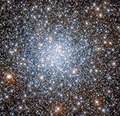File:NGC6638 - HST - Potw2231a.jpg
Appearance

Size of this preview: 622 × 599 pixels. Other resolutions: 249 × 240 pixels | 498 × 480 pixels | 797 × 768 pixels | 1,063 × 1,024 pixels | 2,125 × 2,048 pixels | 2,611 × 2,516 pixels.
Original file (2,611 × 2,516 pixels, file size: 3.35 MB, MIME type: image/jpeg)
File history
Click on a date/time to view the file as it appeared at that time.
| Date/Time | Thumbnail | Dimensions | User | Comment | |
|---|---|---|---|---|---|
| current | 19:53, 1 August 2022 |  | 2,611 × 2,516 (3.35 MB) | Fabian RRRR | == {{int:filedesc}} == {{Information |description={{en|1='''Star-Studded Skyfield This star-studded image from the NASA/ESA Hubble Space Telescope shows the heart of the globular cluster NGC 6638 in the constellation Sagittarius. The star-strewn observation highlights the density of stars at the heart of globular clusters, which are stable, tightly bound clusters of tens of thousands to millions of stars. To capture the data in this image, Hubble used two of its cutting-edge astronomical in... |
File usage
The following page uses this file:
Global file usage
The following other wikis use this file:
- Usage on ar.wikipedia.org
- Usage on ce.wikipedia.org
- Usage on de.wikipedia.org
- Usage on diq.wikipedia.org
- Usage on eo.wikipedia.org
- Usage on es.wikipedia.org
- Usage on eu.wikipedia.org
- Usage on fr.wikipedia.org
- Usage on nl.wikipedia.org
- Usage on tt.wikipedia.org
- Usage on www.wikidata.org


